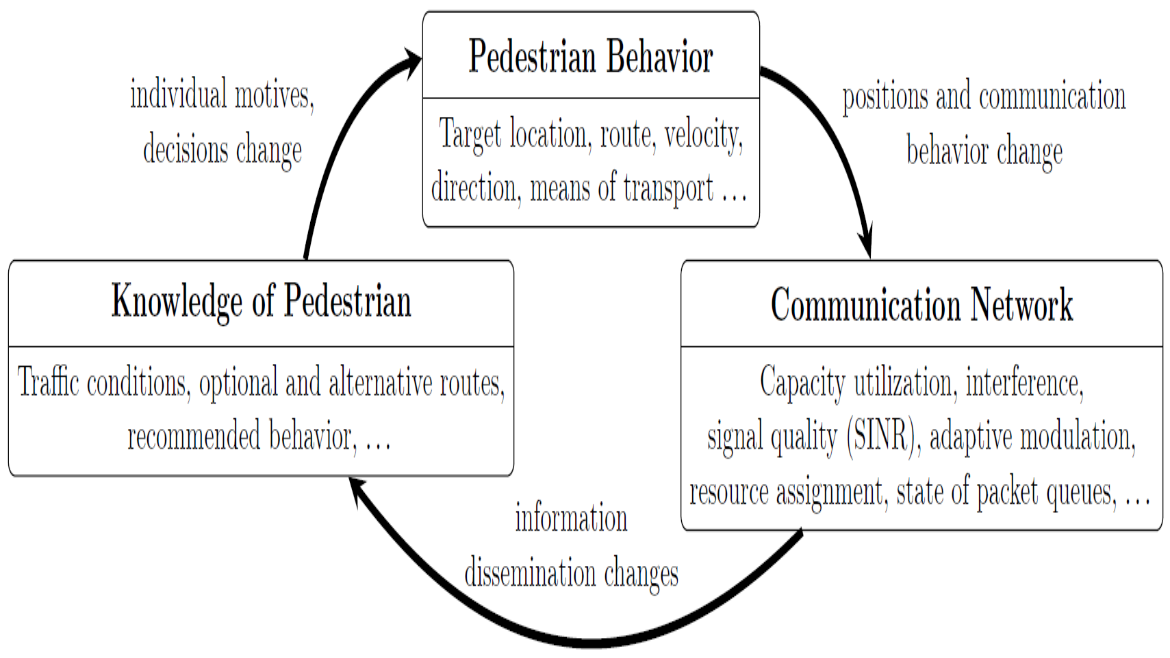roVer
Improving the efficiency of traffic infrastructures by robust internetworking
Prof. Dr. Gerta Köster
Prof. Dr. Lars Wischhof
Computer Science and Mathmatics, Department 07

Networking is a central element of intelligent transport infrastructures and innovative mobility concepts: intelligent vehicles and traffic management systems exchange information to make traffic safer, more efficient and more environmentally friendly. New forms of communication, e.g. via smartphones, enable new mobility concepts such as car and bike sharing. The road participants communicate with each other as well as with mobility service providers and traffic infrastructure. The information distributed in this way via mobile radio thus influences the behavior of road users. At the same time, however, usage behavior and mobility also influence the communication infrastructure - up to and including a complete breakdown of communication, e.g. during major events or in extreme situations such as the Munich attack in July 2016. As intelligent transport systems become more widespread, these interactions between transport infrastructure, user mobility and communication infrastructure will continue to increase. The objective of this project is therefore to systematically investigate the interaction between mobility behavior and wireless networking on the basis of characteristic scenarios and to develop suitable methods for robust networking and information dissemination in these mobility scenarios.
Mobile radio networks of the 5th generation will enable an increase of the available data rate and network capacity as well as new forms of communication. These will change the flow of information and thus also the behavior of road participants who react to the information.

One of the future forms of communication is the direct radio connection between mobile radio devices. This was recently standardized with a further development of the mobile radio standard LTE Advanced. It enables direct communication between subscribers (Device-to-Device Communication, D2D) independently of the cellular network infrastructure. Up to now, however, the usage has been limited to security applications and detection of close subscribers. For the 5th generation mobile radio networks an extension of direct communication to civilian applications is expected. This would allow subscribers to exchange information directly via their smartphone or vehicle. The information that can be useful for intelligent mobility needs to be evaluated. In addition to direct information on the situation - "free Car-Sharing car at pos. X" - this could also include indirect information, such as current driving or walking speeds, which indicate possible traffic jams.
The extension of cellular communication to include the possibility of direct communication between participants (D2D) results in different communication modes. Depending on the local situation of a subscriber or the overall network, the mode can be adapted and communicated either via the base station and/or directly. The choice of the communication mode has a serious influence on the distribution of information in the network. But not only the new communication technology will change the behavior, also the behavior will influence the technology, see Figure 3. The functionality of radio technology is strongly affected by how many road users use the technology at which position:
Interference, for example, lead to errors during transmission, participants in the local environment share the resources, directing antennas towards individual users is much more difficult when traffic density is high. In order to ensure the functioning of intelligent traffic systems even in extreme situations, communication systems and user positions and density must not be examined in isolation.

Existing simulation systems, which jointly simulate road traffic and mobile radio and thus enable the investigation of interactions, focus on the simulation of vehicle traffic. In addition, they are usually not freely available. However, a particularly high density of active, communicating road users is often caused by pedestrians travelling in groups - e.g. after a large event - or changing modes of transport. The roVer project therefore aims to couple state-of-the-art pedestrian flow simulations with radio network simulations for the first time.
This roVer simulation system will then be used to investigate selected characteristic scenarios of intelligent traffic systems, such as the provision of mobility information to smartphone users, communication of sensor data between vehicles, etc., with regard to the robustness of networking. Central and decentral communication mechanisms for intelligent traffic systems, as they are proposed in the literature (e.g. cellular and D2D communication via LTE-A, WLAN-like communication via ITS-G5/WAVE), will be compared and evaluated with regard to their impact on the mobility of users. From this, improvements and new approaches to ensure robust communication will be derived. In addition to the efficient dissemination of information, data protection and IT security will also be considered, e.g. by considering relevant attack models.
Running duration:
01.10.2018 - 30.09.2022
Funded by:
Federal Ministry of Education and Research, Junior-engineers 2016
Project Executing organisation:
VDI Technology Center
Project Partners:
- accu:rate GmbH – Institute for Crowd Simulation
- Stadtwerke München GmbH – Unternehmensbereich Verkehr
- Technische Universität München – Fakultät für Informatik